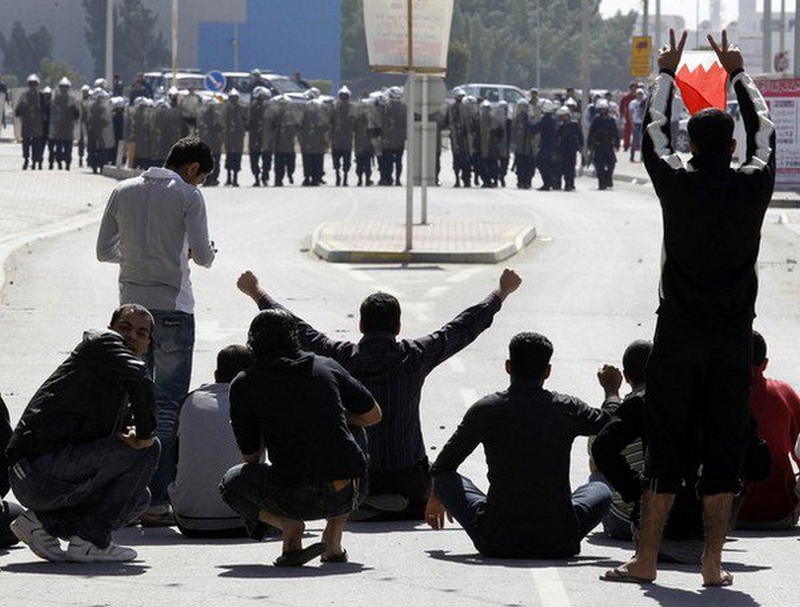
RT @bobboynton new media and the revolting middle east
RT @samiran Protests schedule, Bahrain #feb14, Libya #feb17, Algeria #feb19, Morocco #feb20, Cameroon #feb23, Kuwait #Mar8
 |
Tunisa, Egypt, Bahrain, Libya -- revolt sweeping across the middle east. The enthusiasm for freedom is palpable as the mighty fall or may fall in those countries where they have not yet.
One manifestation of this enthusiasm has been a flood of Twitter messages; YouTube and Facebook have also been active sites for asserting the need for change. The new media have been given a massive workout in these months.
The new media provide us, as scholars, a new vantage point on revolt. We can observe communciation that we have not been able to observe before, and we can use the observations to develop a better understanding of how events like this unfold. I look specifically at the use of Twitter in Bahrain, and then I expand beyond Bahrain to suggest the generality of what I found there.
RT @Ghonim The Power of People is much STRONGER than The People in Power #Bahrain #Feb14
RT @Bahrainiac: First they ignore you, then they laugh at you, then they fight you, then you win #bahrain #feb14
The people and their rulers. The numbers are so disproportionate that the people could overturn the leaders at any time.
2/15/2011 RT @Jnoubiyeh: Confirmed Deaths In #Bahrain: 8-year old Hasan Mahdi, 25-year old Mohammad Saade and 27-year old Ali Mushaimi. #Feb14 #Bahrainis #Manama
That does not mean it is easy. Rulers do not go voluntarily. There is likely to be blood shed and death along the way. But if they perservere the numbers are overwhelming.
That we do not have revolts all of the time is, first, people are more interested in their daily lives than they are reforming the state.
2/16/2011 10:27 PM RT @RshRsho: RT @nadooi_wish: The protests were saying: "With soul, with blood, we live for Bahrain" And they were attacked by the army? #Bahrain #Feb14
But there may come a time when one's daily life is not enough. "We live for Bahrain."
Second, who will go first?
2/27/2011 7:35 AM Female speaker "I am here, I will not go anywhere. I will fight and my weapon is peace" #bahrain #feb14
2/26/2011 1:46 PM RT @maryamalkhawaja: "if it wasn't for the martyrs we wud not be here today, they have freed the detainees and wil free the rest" #martyrssquare #bahrain #feb14
If you step out and the revolution is a success you will be a hero. Very likely a dead hero, a martyr, since those who lead are the ones most likely to feel the wrath of the rulers.
2/26/2011 3:49 PM RT @Bahrainiac: 40% Of Bahrain's Entire Population Attends Latest Protest http://wp.me/p1jYBG-1eD #Bahrain #feb14
2/27/2011 11:26 AM RT @maryamalkhawaja: Chanting "no Sunni no Shias, but a nation demanding freedom" #martyrssquare #bahrain #feb14
To overwhelm the rulers a community of action must come into play. There must be the sense that you do not have to look over your shoulder to see if someone is following. You are not divided. You are acting together.
2/16/2011 7:31 AM RT @maryamalkhawaja: News tht gov thugs are gathering ppl for pro gov rally to bring them to "create disturbances, but we will meet them with roses" cont. #feb14
2/15/2011 10:13 PM RT @aslanmedia: Take a closer look at where the "#Egypt effect" is spreading. http://ow.ly/3X9MO #jan25 #feb14 #feb12
And when you act together you can win. "We will meet them with roses." And that is where the "#Egypt effect" is important. If they could walk together and win so may we.
This is the story of Bahrain as they told it. A community living for Bahrain. Rising up together. But there are no guarantees, and the action is not yet over.
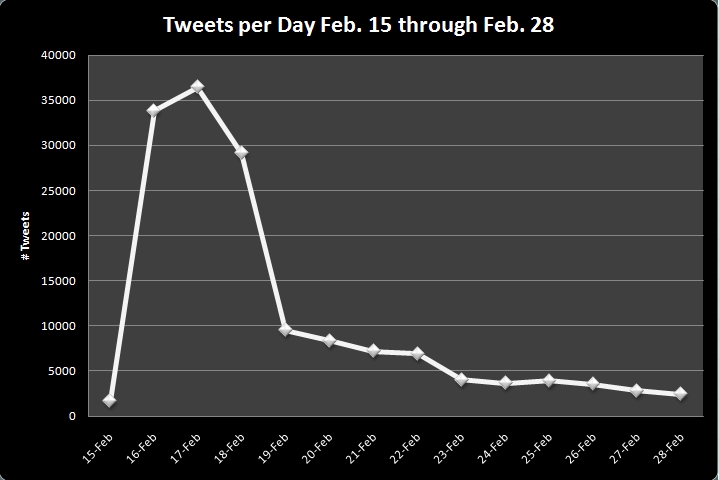 |
To understand how this story unfolded I collected Twitter messages containing the hashtag #Feb14 almost from the beginning to present. #Feb14 is to be their '4th of July' if they are successful. It also associated them with the other revolts that were upending rulers all over this world.
The number of tweets was small the first two days. Then it jumped to over 35,000 for each of the next two days. It declined from there and is averaging about 3,500 a day since. It is a large collection with 153,309 tweets between the 15th and the 28th. It is not nearly as large as the others I will use, but Bahrain is only 1.2 million people and this is large for them.
Much of the discussion of the new media and these revolts has centered on two uses. I have collected a number of these interpretations by information technologists at Information Technologies and Political Rights.
2/15/2011 11:57 PM RT @AJELive: Anti-government demonstrators in #Bahrain to stage fresh protests in around 30mins from Pearl roundabout: http://aje.me/hNUCaH #Feb14
2/15/2011 10:48 PM RT @RedhaHaji: Loud speaker recital of Holy Quran.people r sweeping and picking up debre. More lively and active #bahrain #feb14 #lulu trafic slw bt mvng
One of the regularly discussed uses is for local organization which may range from a call to demonstrate to taking care of the protest 'camp.'
2/15/2011 11:53 PM RT @Nabeelrajab: More photos from Bahrain protests and you are free to use them http://goo.gl/G0X6l #bahrain #feb14
2/16/2011 10:42 PM RT @Warchadi: Please spread this video #bahrain police attacking peaceful protesters #lulu http://t.co/awFggim #feb14
The second is for demonstrating one's plight to the rest of the world. Videos have regularly been uploaded to YouTube and Twitpic has been a favorite site for photographs.
Both are very much present in the Twitter messages coming out of Bahrain.
However, I want to write about a third use. I want to point out the use of Twitter messages to constitute a community that will act together in the face of force from those who they would overthrow.
RT @[user name]
You may have noticed that each of the Twitter messages I quoted began, after date and time, with RT @[user name]. This is the standard form of retweeting, and retweeting is the standard 'we move' in Twitter communication. I read a message I like, I agree with, I want others to see and I retweet it. It is sent to my followers as an attributed quotation. It implicitly says: we know this, we feel this, we will act this. It is the joining of the original messenger, me and my followers.
The 'we' is constituted in the follower relationship that Twitter provides. Any individual can follow any other individual -- where following means receiving the messages the other person writes. So people choose to follow Twitter users whose messages they want to read. They are putting themselves into a common messaging space.
This characterization of the relationship is surely less true for the rock stars of the Twitter world than it is for most others. The rock stars are rock stars. Lady Gaga is recently number one with 8.6 million followers. The only political rock star is Barack Obama with 6.8 million followers -- both on March 6, 2011 as the numbers grow daily. They are rock stars. You do not so much want to read what they write -- especially since you are pretty sure they do not write themselves -- as you want to be in touch, to be in their sphere. That is what it means to be a fan.
But most follower relationships are not about fandom. They are about sharing an interest in what is being tweeted.
Retweeting is constituting community in this follow space. But most of the Twitter-verse is not about retweeting. There were 25 billion messages sent in 2010 [Siegler Dec. 13, 2010]. Only six percent of those 25 billion were retweets [Evans Sept 30, 2010]. Retweeting and constituting a community of shared interest is only a tiny fraction of the communication going on using Twitter. They are mostly busy doing other things.
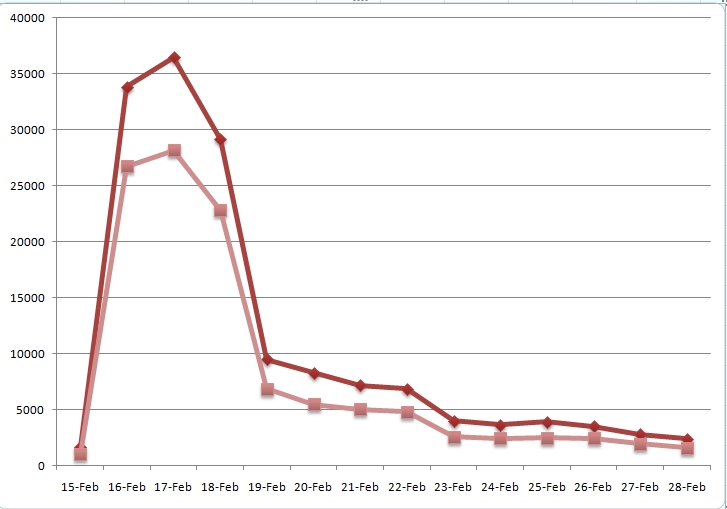 |
What about #Feb14? What is the incidence of retweeting in the tweeting about Bahrain as they rise against their rulers? Two-thirds of the Twitter messages are retweets. The range from day to day is 63% to 79%. But as the figure shows there is not much variation from day to day in the percentage that are retweets.
In this case everything is being retweeted. Messages to help organize the protests are retweeted. Messages to appeal to the world outside Bahrain are retweeted. Messages of joy are retweeted. Messages of grief are retweeted. It is not the content of the message that determines retweet versus not retweet.
Everyone shares in the full range of activities and emotions of the revolt. It is constituting a community that is believing together, that is feeling together and that is acting together. Join me in -- and every aspect of the protests follow after join me.
This is, of course, an interpretation. 'Constituting a community' is not the subject of the messages. Constituting the community is in the style of communication, in the retweeting.
If my interpretation is correct then similar 'episodes' of communication should take this same form. The revolt against rulers in Bahrain was followed closely by the revolt in Libya. If my interpretation is correct then one should find the same high level of retweeting in the Twitter messages emanating from Libya.
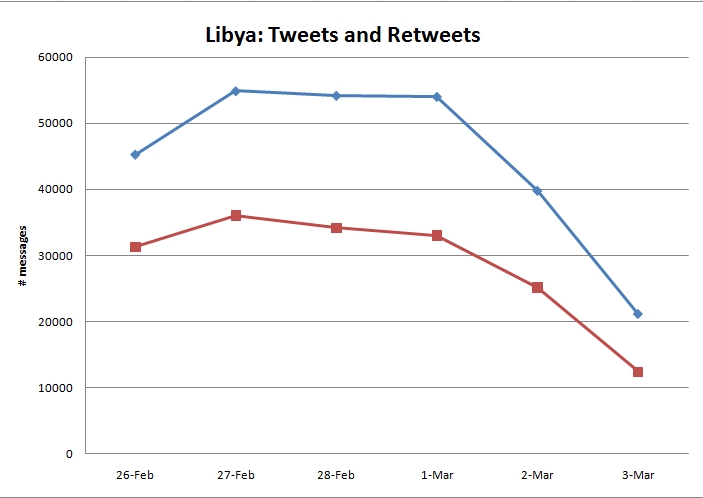 |
I captured the Twitter messages containing the hashtag #libya from the twenty-sixth of February through part of March third. The government turned off all internet communication between Libya and the rest of the world during March 3. The volumn of messaging is substantially greater than for Bahrain; the numbers are 45,000, 54,000, 54,000, 54,000, 40.000, and 21,000 on March 3. But the relationship between Twitter messages and retweeting messages is the same as in Bahrain. Sixty-four percent of all the messages were retweets. And you can see that there is very little change in that from one day to the next.
That seems a remarkably strong confirmation of the interpretation that retweeting is constituting a community, and in these two cases a community of action.
The U.S. was having its own revolt at the same time. The governor of Wisconsin was determined to destroy the unions of the public employees of the state. His original justification was the debt of the state, but the unions agreed to sacrifice their salaries for the good of the state so it became clear that this was union busting -- the unions of teachers, police, fire fighters, and others. And a revolt ensued. The revolt was much like the revolts in Bahrain and Libya with demonstrations, marches, occupying public spaces, and Twitter messaging.
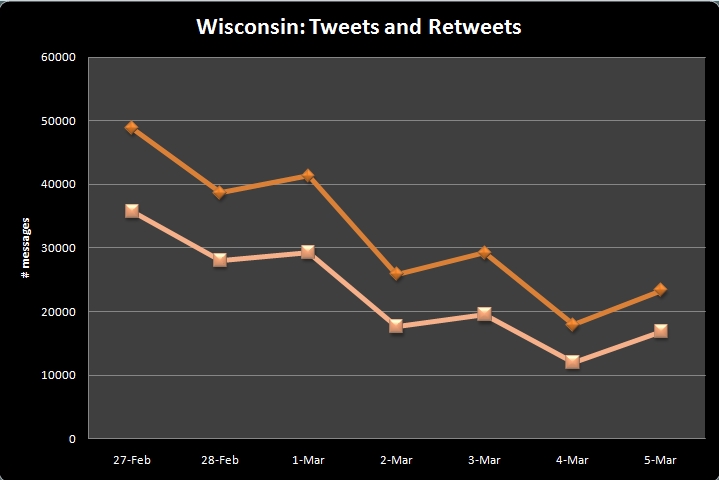 |
I collected Twitter messages with the hashtag #wiunion, which was the chief hashtag of the revolt, February 27 through March 5. The numbers are in the same range as in Libya. On the twenty-seventh there were 49,000 Twitter messages, and 36,000 of them were retweets. Overall, retweets were 70% of all messages. And as the figure shows there was very little variation from day to day.
Move from one to another culture, find revolt and retweeting dominates the messaging. When engaging in revolt constituting community is as important in the U.S. as it was in the middle east. There are the same necessities: planning action and taking one's case to a wider world. And in this communication a community of action is constituted. We must act together to take on the tyrant. While the tryant was not shooting at the rebellious in Wisconsin, he was trying everything he could short of that.
Three cases are similar in the protest in the society and in using retweets for communication. But I need to show that there are high involvement, high concern episodes that produce a high volume of Twitter messaging, but that do not produce a volume of retweets comparable to the first three cases. I will show two cases like this.
Shooting Representative Giffords of Arizona shocked the nation, led to recriminations from all sides about responsibility for the shooting, and left a legacy of interest in the recovery of Representative Giffords that has lasted from January to March. And it produced a very substantial stream of Twitter messages. The shooting did not shock the nation because a resident of an inner city was shot. It did not shock the nation because someone well known was shot. Representative Giffords was little known outside of Arizona and D.C. It shocked the nation because at first it seemed a political threat, a threat to the nation by attempting to kill a member of congress -- even if a member who was not well known. The response to such a threat is to call forth community. When community is challenged the call is to shore up, to defend community. Assuming that interpretation the extent of retweeting should have been highest the first days and decline over time as it became apparent that it was a lone individual acting out his own fantasies, and was not a broad challenge to the nation.
As almost everyone writing about Twitter notes it is frequently used to 'spread the word.' It is a news machine. But if retweeting is not the way the news is spread how is it spread? There is a 'news move' in the practice of Twitter messaging, and it is the use of urls in the message. It is citing an 'external' source which may be a news media website, or a blog of one of the many forms blogs take. But the move is: did you see . . . followed by a reference to where one can see what the person has just alerted readers to. If the Twitter messages about Giffords was primarily news in focus then one would expect the presence of urls in messages to be high and constant over time.
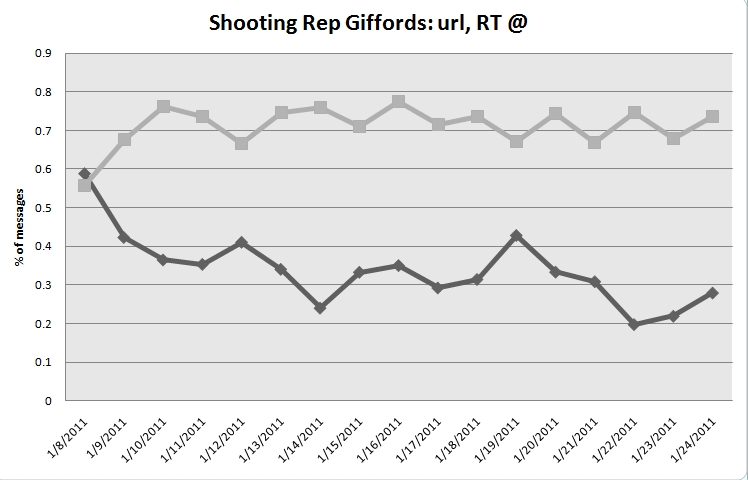 |
The time period covered in the figure is January 8 through January 24, and I collected 463,561 messages for the period. The figure shows the percentage of Twitter messages containing a url, which is the upper line, and the percentage containing a retweet, the lower line. The pattern is very much like expected. Retweeting was more frequent than was the inclusion of urls the first day by a small fraction. The percentage of the messages that were retweets was 59% which was about the same as in the three revolt cases. After the first day Twitter messages containing urls stay in the same range between 65% and 80%. Retweeting drops to 20% to 40%. For the entire data set urls are used in 69% of the messages and in RT @ appears 39% of the messages.
A second case: In February 2010 Chile suffered very serious earthquakes. One day the quake reached 8 on the Richter scale, and on others the quakes reached 6 and 7. It was a very dangerous shifting of the earth. I collected Twitter messages about the earthquakes starting February 27, 2010 and running for another month; the set numbered 206,861 messages. This is a case where one would expect the 'news move' to be more prevalent than the 'we move,' and that is what happened. Sixty-three percent of the messages included a url -- a reference to external sources to which the reader's attention was called. Only 42% included RT @.
The numbers across the five cases provide strong justification for the interpretation that retweening is being used to constitute a community of action when taking on rulers. But there is one more point to address.
How many people see these Twitter messages? If the numbers are as small as 35,000 as the second and third days of the revolt in Bahrain how can one expect them to be important in the revolt? Once installed the advantage of mass media is their reach. Everyone in the society may experience that communication.
2/16/2011 10:28 PM RT @RshRsho: Bahrain tv is showing a program about China!! No comment #Bahrain #feb14
But during periods of revolt the mass media are in the hands of the rulers. They are not going to promote communication that would bring the populace to revolt.
The question, then, is about the reach of Twitter messages. On February 15, 2010 I captured 1,700 messages. In those 1,700 messages about 300 were sets of retweeted messages. Some were retweeted only one time. Some were retweeted a large number of times.
2/15/2011 11:57 PM RT @jilliancyork: Why does the Internet matter in #Bahrain protests? 88% have access, compared to Egypt and Tunisia's 25-30%. #Feb14
I chose one of the retweeted messages to illustrate the reach that retweeting can achieve. jilliancyork wrote the original message it was retweeted 27 times. That means it was available to the followers of all 28 of the individuals. The total number of followers is 48,475. One message, retweeted 27 times, made its way to fifty-four thousand people. If the retweets were all going to the same set of people then there would be a great deal of redundancy in the messaging and many fewer actual recipients. So I checked for mutual followers of each pair of persons retweeting. Only four percent of the 48 thousand were mutual or shared followers. Subtract 2,094 from the 48 thousand to eliminate the redundancy and a single message was sent to 46 thousand.
That was a single message. There were more than 300 being retweeted that day and many more on subsequent days. The reach of retweeting can be very great.
Bahrain, Libya, Wisconsin -- people rising up against their rulers. To rise up they must have a sense that there is a whole community ready to act, that they are part of a large movement. As many writers have noted the new media can be important for helping organize activities. New media can be important in communicating the plight of the persons in revolt to a larger audience. I have added a third importance that one can see new media playing in the revolt. It provides the individuals with the sense that they are part of a movement, a movement large enough to take on the rulers and their guns and succeed.
References
G. R. Boynton (2011, ongoing) Information Technologies and Political Rights
Mark Evans (Sept 30, 2010) An Exploration of Retweets and Replies, Sysomos Blog
M.G. Siegler (Dec 13, 2010), 25 Billion Tweets Were Sent In 2010, And Not All Of Them Were About Bieber, TechCrunch.